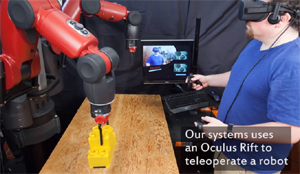



Date:04/10/17
 Researchers from MIT’s Computer Science and Artificial Intelligence Laboratory (CSAIL) have developed a virtual-reality system that lets folks tele-operate a robot using an Oculus Rift headset.
Researchers from MIT’s Computer Science and Artificial Intelligence Laboratory (CSAIL) have developed a virtual-reality system that lets folks tele-operate a robot using an Oculus Rift headset.
Simply strap on the VR device and be transported from your living room to a control room.
The newfangled system, according to MIT, falls somewhere between the two traditional approaches to using VR for tele-operation:
A “direct” design limits the user’s viewpoint to only that of the robot, and a delayed signal may cause nausea and headaches.
A “cyber-physical” configuration separates the robot from the user (who interacts with a virtual copy of the droid), but requires more data and specialized spaces.
CSAIL, however, claims to have solved these problems.
By mimicking the “homunculus model of the mind”—basically the premise of Pixar’s Inside Out—researchers can place a human “inside” a robot, where they can see through its eyes and control its actions.
A pair of Oculus Touch controllers make it easy to manipulate the machine’s hand grippers to pick up, move, and retrieve items.
Watch the video below to see a tele-operated robot complete tasks like stacking blocks, picking up screws, and stapling a wire.
“A system like this could eventually help humans supervise robots from a distance,” CSAIL postdoctoral associate Jeffrey Lipton, lead author on a paper about the system, said in a statement. “By tele-operating robots from home, blue-collar workers would be able to telecommute and benefit from the IT revolution just as white-collar workers do now.”
As you can see, the process appears quite slow (though users with gaming experience reportedly had less trouble navigating the system). Still, when tested against other systems, CSAIL’s technology managed to move 57 percent faster. And it can do so from hundreds of miles away.
Currently limited to the MIT lab, this system will eventually become more scalable, with many users, different types of robots, and increased compatibility.
While the team used Rethink Robotics’ humanoid Baxter and an Oculus Rift, the platform will work with other bots, and is compatible with the HTC Vive VR headset.
Lipton co-wrote the paper with CSAIL director Daniela Rus and researcher Aidan Fay; they presented their findings at this week’s IEEE/RSJ International Conference on Intelligent Robots and Systems (IROS) in Vancouver.
MIT Remotely Operates Robots with Oculus Rift VR
 Researchers from MIT’s Computer Science and Artificial Intelligence Laboratory (CSAIL) have developed a virtual-reality system that lets folks tele-operate a robot using an Oculus Rift headset.
Researchers from MIT’s Computer Science and Artificial Intelligence Laboratory (CSAIL) have developed a virtual-reality system that lets folks tele-operate a robot using an Oculus Rift headset.Simply strap on the VR device and be transported from your living room to a control room.
The newfangled system, according to MIT, falls somewhere between the two traditional approaches to using VR for tele-operation:
A “direct” design limits the user’s viewpoint to only that of the robot, and a delayed signal may cause nausea and headaches.
A “cyber-physical” configuration separates the robot from the user (who interacts with a virtual copy of the droid), but requires more data and specialized spaces.
CSAIL, however, claims to have solved these problems.
By mimicking the “homunculus model of the mind”—basically the premise of Pixar’s Inside Out—researchers can place a human “inside” a robot, where they can see through its eyes and control its actions.
A pair of Oculus Touch controllers make it easy to manipulate the machine’s hand grippers to pick up, move, and retrieve items.
Watch the video below to see a tele-operated robot complete tasks like stacking blocks, picking up screws, and stapling a wire.
“A system like this could eventually help humans supervise robots from a distance,” CSAIL postdoctoral associate Jeffrey Lipton, lead author on a paper about the system, said in a statement. “By tele-operating robots from home, blue-collar workers would be able to telecommute and benefit from the IT revolution just as white-collar workers do now.”
As you can see, the process appears quite slow (though users with gaming experience reportedly had less trouble navigating the system). Still, when tested against other systems, CSAIL’s technology managed to move 57 percent faster. And it can do so from hundreds of miles away.
Currently limited to the MIT lab, this system will eventually become more scalable, with many users, different types of robots, and increased compatibility.
While the team used Rethink Robotics’ humanoid Baxter and an Oculus Rift, the platform will work with other bots, and is compatible with the HTC Vive VR headset.
Lipton co-wrote the paper with CSAIL director Daniela Rus and researcher Aidan Fay; they presented their findings at this week’s IEEE/RSJ International Conference on Intelligent Robots and Systems (IROS) in Vancouver.
Views: 515
©ictnews.az. All rights reserved.Similar news
- The mobile sector continues its lead
- Facebook counted 600 million active users
- Cell phone testing laboratory is planned to be built in Azerbaijan
- Tablets and riders outfitted quickly with 3G/4G modems
- The number of digital TV channels will double to 24 units
- Tax proposal in China gets massive online feedback
- Malaysia to implement biometric system at all entry points
- Korea to build Green Technology Centre
- Cisco Poised to Help China Keep an Eye on Its Citizens
- 3G speed in Azerbaijan is higher than in UK
- Government of Canada Announces Investment in Green Innovation for Canada
- Electric cars in Azerbaijan
- Dominican Republic Govt Issues Cashless Benefits
- Spain raises €1.65bn from spectrum auction
- Camden Council boosts mobile security





















